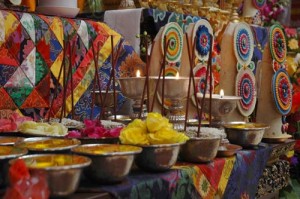Japan is a country steeped in tradition. Many Japanese-Americans still follow these traditions especially those revolving around the major stages of life: birth, marriage, and death.
In Japan, the most common funeral services follow the Buddhist faith. The Buddhist ceremony consists of four parts: a wake, cremation, burial, and memorial services. Japanese-American funeral services follow the same elements although in varying degrees. To understand Japanese-American funeral services, you must first understand the funeral customs and traditions of Japan.
The Wake
At the wake, the body is placed in a casket with the head facing north. Traditionally guests of Japanese funerals wore white, but today it is most common to wear formal black attire. At the wake a Buddhist priest will read a sutra. The priest will be carrying a prayer bead called a juzu. Guests may also be given a juzu upon arrival. Family members will then offer incense before the deceased. Traditionally, condolence money will be offered to the family to help with funeral expenses. People paying their respect will give the family an envelope called a koden which will contain anywhere from fifty to three hundred dollars. At the end of the wake all guests will be given an appreciation gift. Following the wake, close relatives will stay overnight with the deceased.
The Cremation Service
The day after the wake is the day of cremation. The traditional Japanese cremation service differs from traditional cremation in America. In Japan, the casket is taken to the crematorium, and the family watches as the casket is placed inside. The family members then leave and wait for the completion of the cremation. After the cremation is competed the family returns to transfer the bones of the deceased into an urn. This is traditionally done using chopsticks. Family members will pass the bones from chopsticks to chopsticks and into the urn. The order in which the bones are moved is important. The bones must be picked up starting with the feet to the head in order to ensure the deceased is not placed upside down.
Japanese Burial Options
After the cremation service, family and friends may travel directly to the family grave – haka in Japanese – or keep the urn at the family home for several days. Traditionally, the entire family will eventually be buried in a chamber beneath the family grave. Today, it is becoming common to keep the urn or to scatter the ashes in a symbolic location. If the deceased is buried in a family grave, family and guests may leave flowers, water, and incense in front of the site.
Japanese Memorial Customs
Japanese memorial customs depend strongly on family traditions. Generally, the first forty-nine days are very important for the soul of the deceased, since it is believed that the soul does not enter heaven until the forty-ninth day. A common custom is to hold a memorial service every seventh day until the forty-ninth day. At the memorial service, a Buddhist monk will chant a sutra, either at the family’s home or at the local temple. The family and friends will then place fresh flowers and burn incense at the family grave. Everyone will join together for a meal.
Finally, it is very important to understand the religious beliefs of the person who has passed. Japanese Americans vary in traditions and beliefs. The first step in planning a funeral ceremony for a Japanese-American is to consider the beliefs of the deceased. For example, a Christian may want a funeral more similar to the traditional American style. Also, if family still lives in Japan, they should be contacted. They could help shed light on family customs. Lastly, it would be most appropriate to contact a Buddhist temple if attempting to conduct a Buddhist ceremony. They may aid the funeral home in properly performing the Buddhist funeral ceremonies.
Buddhist Offering photograph from acdme on Flickr.
Tags: Funeral Planning, Funeral Services
